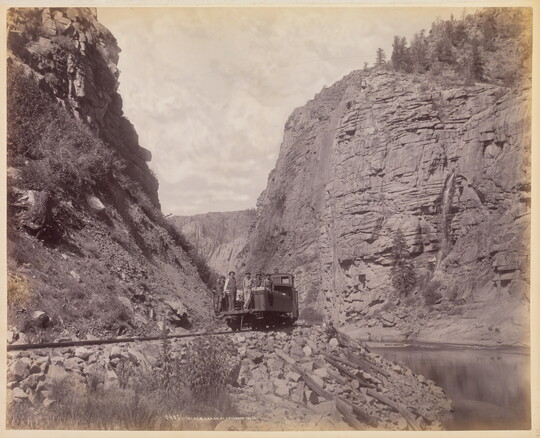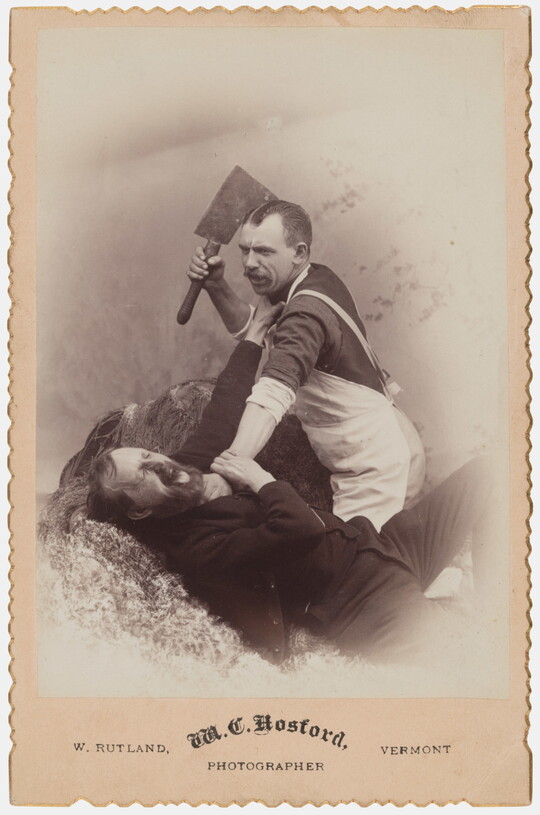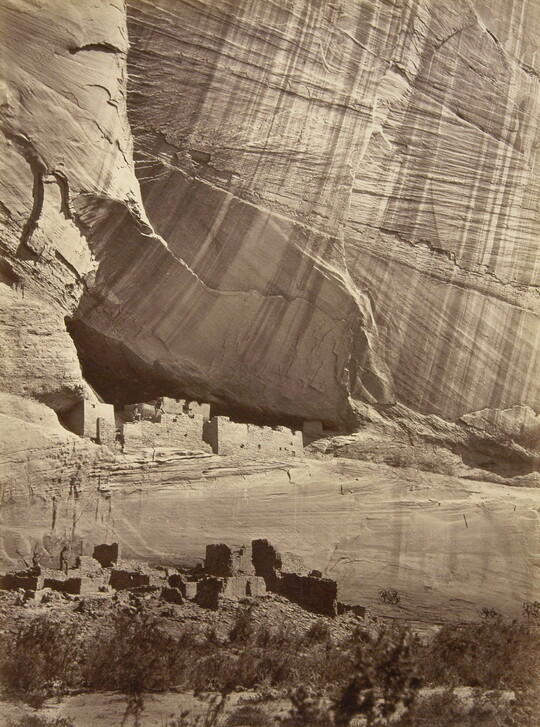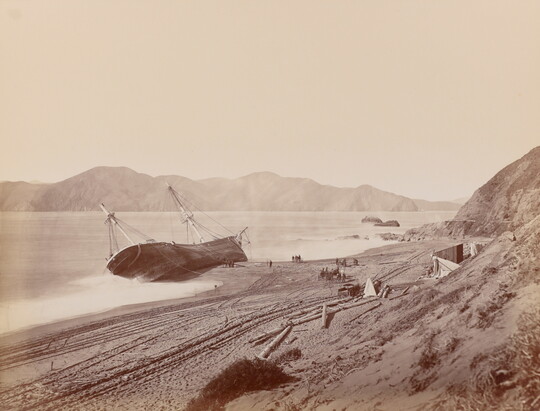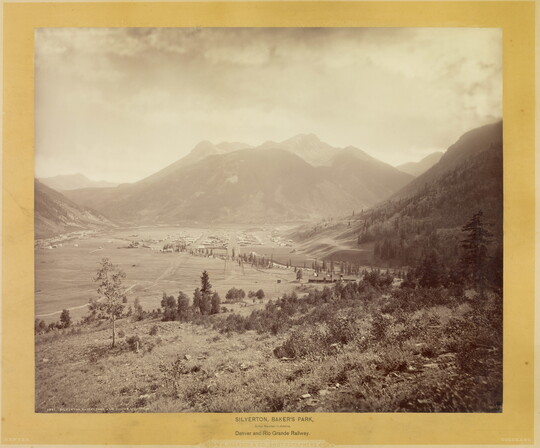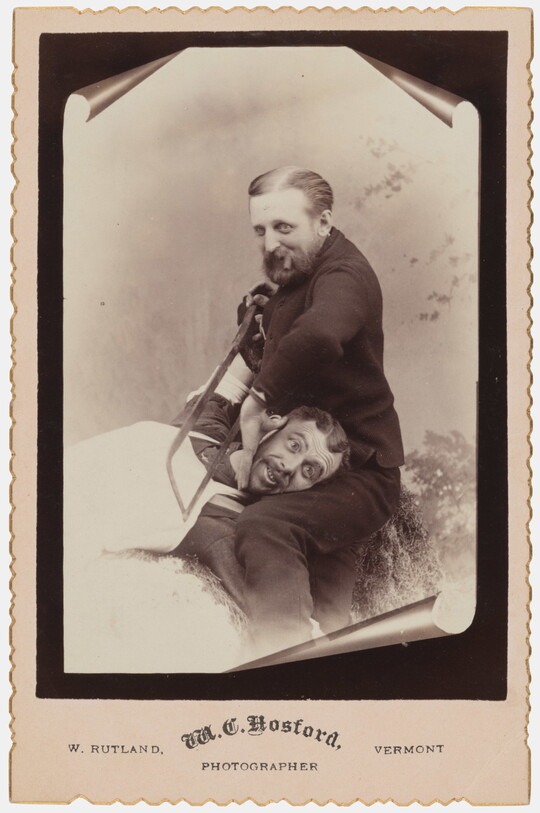



Artwork Images
Photo:
Controls
Tower of Babel, Garden of the Gods
Object Details
-
Date
1880s
-
Object Type
Photographs
-
Medium
Albumen silver print
-
Object Format
Mammoth plate
-
Dimensions
Image: 21 1/4 x 17 in.
Sheet: 21 1/4 x 17 in.
Mount: 28 1/8 x 26 3/4 in. -
Inscriptions
Recto:
l.l. printed in negative: 1007. TOWER OF BABLE [sic]. GARDEN OF THE GODS
l.r. printed in negative: W.H. JACKSON & CO. PHOT. DENVER
Verso, 1st Mount:
l.l. in graphite: WHJ. 105. X
-
Credit Line
Amon Carter Museum of American Art, Fort Worth, Texas
-
Accession Number
P1981.47.2
-
Copyright
Public domain
Additional details
Location: Off view
See more by William Henry Jackson
Tags
-
Why are land and the landscape so important to the national identity of the United States?
How do artists determine which geographical features should be highlighted in portrayals of a nation?
What is the role of photography in the American landscape tradition?
What artistic choices does a photographer make when creating an image?
How might a work of art contribute to the preservation or destruction of land or the environment?
How have artists in different time periods viewed and depicted the American landscape?
-
Describe what you see here. What can you tell about the place that the photographer is in?
What do you think the artist was interested in showing us when he took this photograph? Notice the small figure to the left of the rock formation. Why might the photographer have chosen to include him?
William Henry Jackson was hired by a railroad company to take promotional photographs, including the one that we see here. In what ways is this photograph an advertisement for the railroad? (For older students, be sure to emphasize that the railroad also represented travel, tourism, adventure, the West, etc.)
What might have been the artist’s purpose in creating this landscape in the manner that he did? What decisions has the artist made about the production of his photographs? (William Henry Jackson’s photo is a composite of three different photographs. In order to achieve a range of light and dark, different exposure times were required.)
This image is approximately 21-by-17 inches, a “mammoth plate,” which is very large for the time. How does the size of this photograph affect the viewer’s experience? View this photograph on Google Arts & Culture for closer looking.
These mammoth plate photographs required large cameras and delicate darkroom equipment that had to be transported with the photographer in wagons or on horses. Why would that be worth it to create large print photographs? Would mammoth plate photographs be equally effective in representing portraits as landscape?
Aside from being an advertisement, what other purpose might this photograph have served? Does it say anything about settlement? Conservation?
-
All Levels
Students will research local parks or landmarks in their community and create an advertisement to encourage more people to visit the area. Students may choose to visit the site to photograph or create a work of art in their preferred medium.
Share Educator Resources
Amon Carter Disclaimer
This information is published from the Carter's collection database. Updates and additions based on research and imaging activities are ongoing. The images, titles, and inscriptions are products of their time and are presented here as documentation, not as a reflection of the Carter’s values. If you have corrections or additional information about this object please email us to help us improve our records.
Every effort has been made to accurately determine the rights status of works and their images. Please email us if you have further information on the rights status of a work contrary or in addition to the information in our records.
Related Works
-
Black Cañon at Chipeta Falls, ca. 1880-1885
George E. Mellen
Albumen silver print
P1971.22.51
-
[Getting the cleaver], 1880s
M.C. Hosford
Albumen silver print
P2016.104.B
-
Ancient Ruins in the Cañon de Chelle, N. M. in a Niche 50 Feet above Present Cañon Bed, 1873
Timothy H. O'Sullivan
Albumen silver print
P1982.27.38
-
The Wreck of the Viscata, 1868
Carleton E. Watkins
Albumen silver print
P1980.33
-
Street in Panama., 1871
John Moran
Albumen silver print
P1983.3.12
-
Helena Luy, 1880s
Benjamin Falk
Albumen silver print
P2016.120
-
Silverton, Baker's Park and Sultan Mountain, ca. 1883
William Henry Jackson
Albumen silver print
P1971.94.20
-
[Getting the saw], 1880s
M.C. Hosford
Albumen silver print
P2016.104.A
-
Yo-semite Valley, from the Mariposa Trail. Mariposa County, Cal., 1864
Charles L. Weed
Albumen silver print
P1984.6.1



